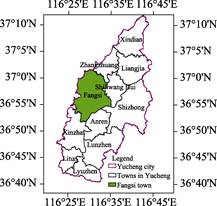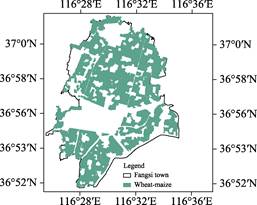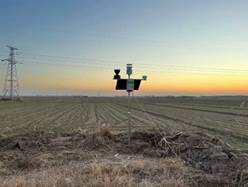Yucheng Wheat-grain Double Cropping Yellow River Irrigation Farmland in Fangsi Town, Shandong Province
Abstract
Yucheng city is located in the alluvial plain of Yellow River in the northwest of Shandong province with a long history in agriculture and is the place where legendary Da Yu tamed the floods. Yucheng is also of the pilot zone for the showcase of saline-alkali soil improvement by the Chinese Academy of Sciences. The case area of Fangsi Town, Yucheng, is located at 37°N, which is moist but not wet in summer and dry but not parch in winter. The unique natural conditions and advanced cultivation make the case area an ideal place for quality special wheat and high starch maize. Wheat-maize double cropping is the characteristic agricultural mode of Yucheng Fangsi. This study collected the data of physical geography, crop varieties, management, and agricultural history of the case area, analyzed the geographical genes of agricultural products, and explored the relationship between environmental protection and sustainable development, so as to provide informed support for the effective link between the ecology and Rural Revitalization in Yucheng. The dataset includes: (1) GIS boundary data of Fangsi town and Yucheng city; (2) physical geographical data, including climate, soil, water and NDVI; (3) quality data of wheat and maize; (4) cultivation data of wheat and maize; (5) standard and quality of wheat processed products; (6) management data of processed wheat products; (7) in situ photos. The dataset is archived in .shp, .xls, .jpg, .pdf and .docx formats with a size of 48.1 MB (45.9 MB in compression).
Introduction
Yucheng city is located in the alluvial plain of the Yellow River in the northwest of Shandong province. Yucheng got its name from Dayu. According to legend, Dayu was one of the earliest tribal leaders of the Chinese people and tamed the flood in today’s Yucheng. It is also an area for Chinese scientists to demonstrate their evolving technologies to treat poor soils on a large scale. Since the 1950s, the Chinese Academy of Sciences and the Chinese Academy of Agricultural Sciences have developed high-standard farmland in the entire area of Yucheng through sand and alkali control, agricultural development, and water-saving irrigation. Fangsi town of Yucheng is located at the golden zone nearby 37°N . It is moist but not wet in summer and dry but not parch in winter. Therefore, it has superior conditions for twice cropping of winter wheat and summer maize. Double cropping of wheat and grain is the typical cropping mode of Fangsi in Yucheng. This study comparatively analyzes the multiple datasets of physical geography, crop varieties, cultivation management, and history of the Yucheng wheat-grain double-ripening Fangsi irrigation area, and explores the collaborative relationship between environmental protection and sustainable development in the case area, aiming to provide a feasible case for the compelling connection between ecological civilization construction and rural revitalization in Yucheng.
Metadata of the Dataset
The metadata of the Wheat-maize double cropping field in Yellow River Irrigation Fangsi Town case dataset on environment protection and sustainable development[1] is summarized in Table 1. It includes the dataset full name, short name, authors, year of the dataset, temporal resolution, spatial resolution, data format, data size, data files, data publisher, and data sharing policy, etc.
Table 1 Metadata summary of Wheat-maize double cropping field in Yellow River Irrigation Fangsi Town case dataset on environment protection and sustainable development[1]
| Items | Description | |
|---|---|---|
| Dataset full name | Wheat-maize double cropping field in Yellow River Irrigation Fangsi Town case dataset on environment protection and sustainable development | |
| Dataset short name | YuchengWheatMaizeCase09 | |
| Authors | Wang, Z. B., Institute of Geographic Sciences and Natural Resources Research (IGSNRR), Chinese Academy of Sciences (CAS), wangzb@igsnrr.ac.cn Li, K. X., IGSNRR, CAS, likx@igsnrr.ac.cn Huang, Y. H., IGSNRR, CAS Lyu, J. L., Institute of Wheat Research, Dezhou Academy of Agricultural Sciences Zhou, L., Yucheng Municipal Government Chen, X., Yucheng Municipal Bureau of Agricultural and Rural Affaires Li, T., Yucheng Municipal Bureau of Agricultural and Rural Affaires Wen, D. H., Fangsi town local government, Yucheng Ni, W. T., Fangsi town local government , Yucheng Shao, Y., Yucheng Maixiangyuan Food Co., Ltd. Zhu, X. G., Beijing Tianhang Create Technology Co., Ltd. Liu, J., Yucheng Municipal Bureau of Agricultural and Rural Affaires Shao, J., Yucheng Municipal Bureau of Agricultural and Rural Affaires Chen, L. J., Yucheng Municipal Bureau of Agricultural and Rural Affaires | |
| Geographical area | Fangsi, Yucheng city, Shandong province | |
| Year | 1991-2021 | |
| Data format | .shp, .pdf, .xls, .docx, .jpg | |
| Data size | 48.1 MB | |
| Data files | Case range, physical geography, variety characteristics, operational management | |
| Foundation | Chinese Academy of Science Institution-Local Cooperation Project | |
| Data publisher | Global Change Research Data Publishing & Repository, http://www.geodoi.ac.cn | |
| Address | No. 11A, Datun Road, Chaoyang District, Beijing 100101, China | |
| Data sharing policy | Data from the Global Change Research Data Publishing & Repository includes metadata, datasets (in the Digital Journal of Global Change Data Repository), and publications (in the Journal of Global Change Data & Discovery). Data sharing policy includes: (1) Data are openly available and can be free downloaded via the Internet; (2) End users are encouraged to use Data subject to citation; (3) Users, who are by definition also value-added service providers, are welcome to redistribute Data subject to written permission from the GCdataPR Editorial Office and the issuance of a Data redistribution license; and (4) If Data are used to compile new datasets, the ‘ten per cent principal’ should be followed such that Data records utilized should not surpass 10% of the new dataset contents, while sources should be clearly noted in suitable places in the new dataset[2] | |
| Communication and searchable system | DOI, CSTR, Crossref, DCI, CSCD, CNKI, SciEngine, WDS/ISC, GEOSS |
DOI: https://doi.org/10.3974/geodp.2021.04.05
CSTR: https://cstr.escience.org.cn/CSTR:20146.14.2021.04.05
Dataset Availability Statement:
The dataset supporting this paper was published and is accessible through the Digital Journal of Global Change Data Repository at: https://doi.org/10.3974/geodb.2021.12.44.V1 or https://cstr.escience.org.cn/CSTR:20146.11.2021.12.44.V1
Geographical Scope of the Case Area
The case study area is located at Fangsi town. Fangsi is a town under the jurisdiction of Yucheng, Dezhou city (prefecture), Shandong province, with an area of 146.24 km2. Fangsi town has 11 communities and 123 administrative villages. The geographical scope is the farmland of wheat-maize in Fangsi town, with a total area of 63.96 km2 (Figure 1, 2).
Ecological and Geographical Environment
The case area is located in the alluvial plain in the middle and lower reaches of the Yellow River, which is classified as the warm temperate semi-humid monsoon climate area and is a typical alluvial plain. The parent material for soil formation is Yellow River alluvial and sediment. The soil surface texture is mostly medium loam, and the soil layer is deep and easy to cultivate[3]. Soil pH is generally neutral or slightly alkaline and rich in nutrients, such as nitrogen, phosphorus, and potassium. The case area is a yellow-diversion irrigation area located in the second largest irrigation sector in the lower reaches of the Yellow River.
Climatic Conditions
Yucheng is in a warm-temperate semi-humid continental monsoon climate zone, where there is plenty of heat and light, as well as simultaneous rain and heat, which makes it ideal for agriculture. The average temperature in this region is 13.1 °C, and the average precipitation is about 567 mm (1,144.4 mm in wet years and 238 mm in dry years).
Precipitation shows a clear seasonal pattern with most precipitation occurring in summer (65 % of the total per year), and less in the winter and spring (20 % of the total per year)[4]. According to Fangsi town’s meteorological data for the past 30 years (provided by Yucheng Meteorological Bureau), monthly meteorological data for the past 30 years in the case area are shown in Figure 3-6. During the wheat flowering and maturity period (April to June), the average temperature in the case area over the past 30 years is 20.36 °C, and the average daily temperature range is from 11.3 to 11.6 °C. It is beneficial for wheat grains to improving the protein content as well as to extending dough stability times[4], which are favorable for the production of high-quality wheat.
| Figure 3 Monthly average sunshine hours | Figure 4 Monthly average temperature |
|---|---|
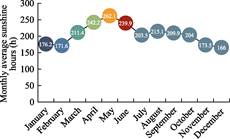 |
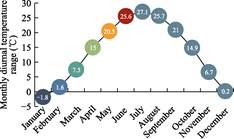 |
| Figure 5 Monthly precipitation | Figure 6 Monthly diurnal temperature range |
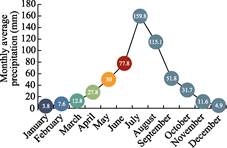 |
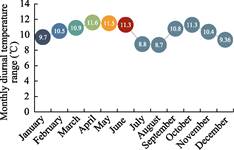 |
Soil Physic-Chemical Properties
The soil type of Fangsi town is brown soil, which is medium loam and sandy loam[3]. Soil samples from two layers were collected in this study. Cadmium (Cd), chromium (Cr), nickel (Ni), lead (Pb), zinc (Zn), and copper (Cu) content (mg/kg), and pH were measured by the Physicochemical Analysis Center of the Institute of Geographic Sciences and Resources, Chinese Academy of Sciences. The soil samples showed no detectable cadmium (Cd), with the detection of chromium (Cr) in the range of 69.8 to 88.6 mg/kg, nickel (Ni) in the range of 38.7 to 48.2 mg/kg, lead (Pb) in the range of 41.8 to 50.2 mg/kg, zinc (Zn) in the range of 32.2 to 63.0 mg/kg, and copper (Cu) in the range of 22.6 to 25.9 mg/kg. The detection of pH was near neutral and was good for soil microorganisms (Table 2). Sampling tests revealed a good soil environment, and the heavy metal content is far lower than the pollution risk screening value and risk control value designated by the National agricultural soil standard.
Table 2 Soil pH and heavy metals of the case area
| Test items | Fangsi town (0-10 cm) | Fangsi town (10-20 cm) | Yucheng (0-10 cm) | Yucheng (10-20 cm) | GB15618—2018 National standard: arable soil risk | |
|---|---|---|---|---|---|---|
| Screening value | Control value | |||||
| pH | 6.7 | 6.9 | 6.9 | 6.9 | ||
| Cd (mg/kg) | Undetected | Undetected | Undetected | Undetected | 0.3 | 3.0 |
| Cr (mg/kg) | 88.6 | 72.9 | 70.1 | 69.8 | 200.0 | 1000.0 |
| Ni (mg/kg) | 48.2 | 42.1 | 38.9 | 38.7 | 100.0 | |
| Pb (mg/kg) | 50.2 | 42.7 | 41.8 | 43.5 | 120.0 | 700.0 |
| Zn (mg/kg) | 32.2 | 63.0 | 35.8 | 36.5 | 250.0 | |
| Cu (mg/kg) | 25.9 | 23.4 | 22.7 | 22.6 | 100.0 |
Water Quality
Surface water and groundwater samples were collected from Fangsi town and its surrounding areas.
The chromium (Cr), manganese (Mn), iron (Fe), nickel (Ni), copper (Cu), zinc (Zn), arsenic (As), cadmium (Cd), and lead (Pb) concentration (mg/L) and pH for aqueous environment in the case area were determined by the Physicochemical Analysis Center of Institute of Geographic Sciences and Resources of the Chinese Academy of Sciences (Table 3, 4). Samples showed that the pH of surface water and groundwater and the content of heavy metals in Fangsi Town meet the National Class I standards of surface water and groundwater.
Table 3 Statistics of surface water quality of the case area
| Test items | Fangsi town | Yucheng | GB3838—2002 National surface water standard | |
|---|---|---|---|---|
| Class I | Class III | |||
| pH | 6.6 | 6.6 | 6-9 | 6-9 |
| Cr (mg/L) | 0.000 | 0.000 | 0.01 | 0.05 |
| Mn (mg/L) | 0.001 | 0.023 | 0.1 | 0.1 |
| Fe (mg/L) | 0.001 | 0.007 | 0.3 | 0.3 |
| Ni (mg/L) | 0.002 | 0.001 | 0.02 | 0.02 |
| Cu (mg/L) | 0.002 | 0.001 | 0.01 | 1.0 |
| Zn (mg/L) | 0.000 | 0.001 | 0.05 | 1.0 |
| As (mg/L) | 0.008 | 0.009 | 0.02 | 0.05 |
| Cd (mg/L) | 0.000 | 0.000 | 0.001 | 0.005 |
| Pb (mg/L) | 0.000 | 0.000 | 0.01 | 0.05 |
Table 4 Statistics of groundwater quality in case area
| Groundwater environment | Fangsi town | Yucheng | GBT14848-2017 National groundwater standard | ||
|---|---|---|---|---|---|
| Class I | Class III | Class IV | |||
| pH | 6.6 | 6.4 | 6.5-8.5 | 6-9 | 6-9 |
| Cr (mg/L) | 0.000 | 0.000 | 0.005 | 0.05 | 0.1 |
| Mn (mg/L) | 0.000 | 0.383 | 0.050 | 0.1 | 1.5 |
| Fe (mg/L) | 0.000 | 0.002 | 0.100 | 0.3 | 2.0 |
| Ni (mg/L) | 0.000 | 0.000 | 0.002 | 0.02 | 0.1 |
| Cu (mg/L) | 0.000 | 0.001 | 0.010 | 1.0 | 1.5 |
| Zn (mg/L) | 0.000 | 0.001 | 0.050 | 1.0 | 5.0 |
| As (mg/L) | 0.001 | 0.004 | 0.001 | 0.01 | 0.05 |
| Cd (mg/L) | 0.000 | 0.000 | 0.000 | 0.005 | 0.01 |
| Pb (mg/L) | 0.000 | 0.000 | 0.005 | 0.00 | 0.1 |
Varieties and Quality of Wheat and Maize
In the case area, the dominant wheat varieties are Jimai 44 and Shiluan 02-1, and the leading maize variety is Denghai 605. The variety and quality data of wheat and maize are provided by Bureau of Agricultural and Rural Affaires of Yucheng city[5].
Varieties of Wheat and Maize
Wheat: Jimai 44 (Figure 7). Accession number is Lu Wheat 20180018. This variety is winterness. The seedlings are semi creeping; the plant type is semi compact; the leaf color is light green; the flag leaves rush up; the lodging resistance is good and the ripening color is good. It has a long awn, a white shell, a white grain, and a hard grain among other characteristics.
Wheat: Shiluan 02-1 (Figure 8). Accession number is National Wheat 2007016. This variety is semi-winterness. The seedlings are creeping, with strong tillering ability and high panicle rate. The plant type is compact; the leaf color is light green; the leaf is small and lifted up, and the spike layer is tidy. The spike is spindle type, with short villus, long awn, white shell, white grain, full grain and horny.
Maize: Denghai 605 (Figure 9). Accession number is National Maize 2010009. This variety is compact, with a plant height of 259 cm and a spike height of 99 cm. The spike is long tube type with 18 cm long; the number of rows per spike is 16-18 with rea axis; The grain is yellow and horse tooth shape, while 100 grains weigh 34.4 g.
| Figure 7 Wheat variety: Jimai 44 | Figure 8 Wheat variety: Shiluan 02-1 | Figure 9 Maize variety: Denghai 605 |
|---|---|---|
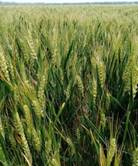 |
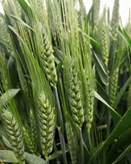 |
 |
Quality of Wheat and Maize
The wheat quality data are shown in Table 5. Jimai 44 has a grain bulk density of 788.9 g/L, a grain protein content of 15.4% in grains, a wet gluten content of 35.1%, and a stabilization time of 25.4 minutes. Shiluan 02-1 has a grain bulk density of 820 g/L, a protein content of 17%-18% in grains, 41% in wet gluten and a stabilization time of more than 20 minutes.
Wheat quality of Fangsi town exceeded National standard GB/T 17892—1999, achieving the first grade of wheat and strong gluten wheat. In a horizontal comparison, it is evident that Fangsi town produces superior wheat compared to those planted in other origins. Pull-breaking force is significantly correlated with crude protein content of wheat flour and stability time, which is the key index for the sensory evaluation of cooked wheaten food[6]. The wheat varieties in the case area have high protein content and long stabilization time, indicating that they have superior characteristics.
The data of maize variety Denghai 605 in Fangsi town is shown in Table 6. The grain bulk density of grain is 766 g/L, exceeding national maize standard (Class I); the crude protein content is 9.35%, crude fat content is 3.76%, crude starch content is 73.40%, lysine content is 0.31%, which are higher than that of maize products from other origins.
Table 5 Wheat quality inspection in Fangsi Town
| Varieties of wheat | Grain bulk density (g/L) | Grain protein (%) | Wet gluten (%) | Stabilization time (minutes) |
|---|---|---|---|---|
| Jimai 44 | 788.9 | 15.4 | 35.1 | 25.4 |
| Shiluan 02-1 | 820 | 17-18 | 41 | >20 |
| GB/T 17892—1999 National standard high-quality wheat, strong gluten wheat (Class I) | 770 | 15 | 35 | 10 |
| Shiluan 02-1 (Luancheng, Hebei province)[7] | 777 | 14.34 | 31.80 | 12.9 |
| Shiluan 02-1 (Mixed samples from Xingtai and Handan, Hebei province, Anyang and Xinxiang, Henan province) [8] | 787 | 12.91 | 31.80 | 22.0 |
Table 6 Quality comparison of maize in Fangsi with national standards and maize in other parts of China[9]
| Maize varieties | Grain bulk density (g/L) | Crude protein (%) | Crude fat (%) | Crude starch (%) | Lysine (%) |
|---|---|---|---|---|---|
| Denghai 605 | 766 | 9.35 | 3.76 | 73.40 | 0.31% |
| National standard GB 1353— 2018 maize (First Category) | 720 | ||||
| Shandong | 739 | 9.8 | 4.2 | 71.1 | - |
| Hebei | 748 | 9.1 | 3.9 | 71.5 | - |
| Shanxi | 753 | 9.3 | 3.7 | 71.3 | - |
| Inner Mongolia | 745 | 8.8 | 4.1 | 71.5 | - |
| Liaoning | 756 | 9.2 | 4.2 | 71.4 | - |
| Jilin | 738 | 8.8 | 4.2 | 71.8 | - |
| Heilongjiang | 717 | 8.4 | 4.4 | 71.7 | - |
| Henan | 735 | 9.8 | 4.0 | 71.5 | - |
| Shanxi | 727 | 9.4 | 3.7 | 71.1 | - |
Wheat Products
Wheat Product Standards
The wheat products in the present case study include dumpling flour, steamed bread flour and whole wheat flour in the ready mixed flour of pastry produced by Yucheng Maixiangyuan Food Co., Ltd. The followed standards are: National standard for wheat flour (GB/T 1355—1986), Wheat flour for shandong dumplings (T/SDAS 70—2019), Wheat flour for shandong steamed bread (T/SDAS 71—2019), and Wheat flour for Shandong noodles (T/SDAs 72—2019).
Wheat Product Quality
Dumpling powder, steamed bread flour and whole wheat flour produced by Yucheng Maixiangyuan Co., Ltd. have obtained green food certification. The nutrition test report of the pastry ready mixed powder shows that: The energy content is 1,523 kJ/100g; the contents of protein, fat and carbohydrate are 24.4%, 1.7% and 61.5% respectively.
Management and Traditional Culture of Wheat and Maize in Yucheng
Management
Scientific and Standardized Planting
(1) Agricultural calendar of winter wheat-summer maize planting model. The key periods of winter wheat-summer maize system are listed in Table 7.
(2) Key measures to promote agriculture in case area are summarized as follows:
-
Promote agricultural industry through land concentration and crop structure adjustment; 2) build a grain industry chain of “institute + government + enterprise + cooperative + service center”; 3) establish an industrial cluster of high-quality wheat along the Yellow River in Shandong; 4) uplift water use efficiency by using the agricultural decision support system of the CAS; 5) extend quality varieties such as high gluten wheat and quality maize, together with Shandong Seed Group; 6) Build the brand of “37°N High-Quality Wheat”; 7) promote whole-process land trusteeship services, together with Shandong Agricultural Group. Once the Group signs a contract with farmers, it will uniformly provide seed, farming, sowing, pest control, harvesting and other services; 8) Cultivate precision agriculture, and optimize all elements of agriculture (soil, seeds, machinery, etc.)
Table 7 Agricultural calendar and main field management in case area
| Crop | Month | Agricultural calendar | Field management measures |
|---|---|---|---|
| Wheat | Mid and late Sept. | Before sowing | Preparation of seed and fertilizer |
| Early to mid Oct. | Wheat sowing | Sufficient fertilizer and fine land treatment to ensure quality | |
| Mid Oct.-mid Dec. | Before dormancy | Ensure full and even seedlings before winter | |
| March | Wheat rejuvenation | Tailored irrigation and fertilization for various fields | |
| April-May | Jointing to grouting | Irrigation and fertilization, prevent diseases and insect pests | |
| Late May-early June | Wheat ripening | Timely harvest | |
| Maize | Mid and late May | Before sowing | Preparation of seed and fertilizer |
| Early to mid June | Maize sowing | Ensure full and even seedlings | |
| Mid June-early July | Seedling | Ensure strong maize seedlings | |
| Early July-early Aug. | Jointing-heading | Remove weak plants, apply fertilizer, prevent disease and lodging | |
| Early Aug. -late Sept. | Heading-maturity | Irrigation and fertilization, timely harvest |
Long-term Habitat Observation
To better manage wheat and maize in the case area, a billboard for the scope of the case area (Figure 10) and a ground observation station (Figure 11) were set up in Fangsi town. The station is a low-power internet of things sensing system, which can collect key crop growth environment factors all day: landscape, meteorological elements, air quality, soil, water, crop growth, diseases and pests.
Long-Term Habitat Observation
To better manage wheat and maize in the case area, a billboard for the scope of the case area (Figure 10) and a ground observation station (Figure 11) were set up in Fangsi town. The station is a low-power internet of things sensing system, which can collect key crop growth environment factors all day: landscape, meteorological elements, air quality, soil, water, crop growth, diseases and pests.
The Role of Agricultural Enterprises: Yucheng Maixiangyuan Food Co., Ltd.
The business of Yucheng Maixiangyuan Food Co., Ltd. includes wheat planting, flour R &D, pasta processing training, e-commerce, agricultural tourism, etc. It is the first listed enterprise in China for steamed bread, a high standard whole chain enterprise of Chinese staple food, a leading enterprise and standardized wheat planting base in Shandong province. The company’s technologies, “three-time-proofing, three-time-rising, eight-time-noodle- pressing, low temperature proofing production”, have obtained the national patent of new technologies. Aided by Yucheng Agricultural Chamber of Commerce, Maixiangyuan improved its links with local farmers, provided them with unified wheat seeds and standardized field techniques, promoted the large-scale wheat cultivation and uplifted the quality of wheat. Maixiangyuan also cooperated with the Chinese Academy of Sciences to establish a brand staple grain R&D base to enhance the brand value of wheat products.
History of Land Use
The History of Special Wheat Cultivation
As early as 2000, Shandong conducted the land zoning for special wheat and classified Dezhou into the most suitable area for special wheat[10,11]. In 2009, the national wheat zoning by the Ministry of Agriculture included five high-quality wheat producing areas, of which Dezhou (Prefecture) is one of the most suitable areas for high-quality strong gluten and medium gluten wheat. Dezhou further detailed the main production areas of special wheat to county-level bases, such as Wucheng, Pingyuan, Qihe, and Yucheng. Wheat is No.1 crop in Yucheng. Normally, the sowing area is 49,000 ha and the yield is 395,000 tons. Yucheng was awarded the “National Super Grain-Producing County”[4]. Yucheng encourages high-quality wheat processing industry. At present, there are large grain enterprises such as Yufei Flour, Zhanyue Food and Dezhou Jinbo. In 2019, the Guidelines for Grain Industry and Rural Revitalization was published.
Improvement of Saline-Alkali Soil in Yucheng
Before 1960, the proportion of poor soil in Yucheng was as high as 43%, mainly saline and alkali soil. Since the 1960s, scientists from the Chinese Academy of Sciences (CAS), have started the research on the improvement of saline alkali soil in the lower reaches of the Yellow River, and set up research bases. By the late 1980s, large scale (667 ha) saline alkali soil improvement demonstration fields had been established.
Meanwhile, the research base in Yucheng was developed into Yucheng Experimental Station of Chinese Academy of Sciences in 1979, run by the Institute of Geography of Chinese Academy of Sciences (CAS). Over the past 40 years, based on the Station, CAS has developed a number of technical systems to meet the needs in different agricultural stages. For example, “Well Irrigation and Well Drainage” technology for salt and alkali soil improvement in 1960s; “Well, Ditch, Leveling, Fertilizer, and Forest” technology for salt and alkali soil improvement in the 1970s (wheat-maize double cropping is one of the key parts); Comprehensive technology for severe saline-alkali and sandy soil improvement in 1980s; Efficient planting and animal husbandry technology in the 1990s; comprehensive technology for maize production and recycling industry in the 2000s[12].
Thanks to these saline and alkali soil improvement technologies, the grain yield per unit area under the “wheat-maize double cropping system” in Yucheng city has reached 15 ton /ha in 2021. In the future, with the improvement of farmland infrastructure (ditch, bridge, road, canal, culvert, well, forest and electricity), as well as the construction of the water source project of Shinu lake and the clean-up and siltation project of Tuhai river, the soil productivity of Yucheng will be further improved, and the maize yield in the core area is expected to be 22.5 ton/ha.
Discussion and Conclusion
Fangsi town of Yucheng, located in the alluvial plain of the Yellow River, boasts suitable climate, soil and water resources for quality winter wheat and summer maize double-cropping. Appropriate natural conditions, combined with effective cultivation techniques, have nurtured high-quality wheat and maize products with geographic characteristics. Through this case study, the relevant data and knowledge have been collected, analyzed and published, including the natural geographic data, variety data, management data, and historical data. Based on this effort, we have provided useful ideas and scientific and technological support for Yucheng to promote its rural revitalization and the healthy development of modern agriculture.
References
[1] Wang Z. B., Li K. X., Huang Y. H., et al. Wheat-maize double cropping field in Yellow River Irrigation Fangsi Town case dataset on environment protection and sustainable development [J/DB/OL]. Digital Journal of Global Change Data Repository, 2021. https://doi.org/10.3974/geodb.2021.12.44.V1. https://cstr.escience.org.cn/CSTR:20146.11.2021.12.44.V1.
[2] GCdataPR Editorial Office. GCdataPR data sharing policy [OL]. https://doi.org/10.3974/dp.policy.2014.05 (Updated 2017).
[3] Liu, Z. H. Status and development strategy of high quality special wheat industrialization in Yucheng [D]. Tai’an: Shandong Agricultural University, 2014.
[4] Wang, D., Yu, Z. W, Zhang, Y. L. Meteorological regionalization for quality strong gluten and medium gluten wheat in Shandong Province [J]. Chinese Journal of Applied Ecology, 2007(10): 2269–2276.
[5] Yucheng Agricultural and Rural Bureau. Operating procedures for major agricultural varieties and technologies in Yucheng City [R]. 2021.
[6] Ministry of Agriculture and Rural Affairs of the P. R. China. China wheat quality report in 2013[R]. 2013.
[7] Jia, X. X., Cao, Y., Wang, S. B., et al. Quality analysis of strong-gluten wheat and common wheat in some areas in 2016 [J]. Cereal and Feed Industry, 2017(8): 8–15.
[8] National Food and Strategic Reserves Administration. Quality report newly harvested maize in 2019 [R]. 2019.
[9] Liu, T. T., Zhang, W. J., Peng, J. Y., et al. Correlation analysis between quality of high-quality strong- and medium-gluten wheat flour and noodle properties in Huanghuai wheat area [J/OL]. Journal of the Chinese Cereals and Oils Association: 1–10 [2021-12-26]. http://kns.cnki.net/kcms/detail/11.2864.ts.20211203. 2258.005.html.
[10] Wu, T. Q., Guo, H. H., Zhang, X. J., et al. Planting regionalization of high quality special wheat in Shandong province [J]. Journal of China Agricultural Resources and Regional Planning, 2002(5): 4–8.
[11] Li, Y. G., Yu, Z. W., Liang, X. F., et al. Planting regionalization for high gluten wheat in Shandong Province [J]. Shandong Agricultural Sciences, 2001(5): 3–9.
[12] Ouyang, Z., Wu, L. F., Wang, C. J., et al. Practice of resource-thrift modern agriculture in Yucheng, Shandong province [J]. Bulletin of Chinese Academy of Sciences, 2011, 26(4): 383–389.
Case Team
Principle Investigator
Principle Investigator Wang Zhenbo
Wang Zhenbo, Professor of Institute of Geographic Sciences and Natural Resources Research,Chinese Academy of Sciences, and Doctoral supervisor. Graduated from the School of Geography and Marine Sciences at Nanjing University in June 2010 with a PhD in Human Geography. Visiting scholar at the University of Washington, member of the Chinese Geographical Society, and Secretary General of the China Urban Agglomeration Research Base Alliance. Research areas: Urban and regional planning, urbanization and environmental effects research, with a focus on the environmental pollution effects of urbanization in urban agglomeration areas.
Expert members of the case team
Li Kexin, Associate Professor, Institute of Geographic Sciences and Natural Resources Research, Chinese Academy of Sciences
Huang Yaohui, graduate student, Institute of Geographic Sciences and Natural Resources Research, Chinese Academy of Sciences
Lv Jinling, Professor, Institute of Wheat Research,Dezhou Academy of Agricultural Sciences
Zhou Lei, Standing Committee Member and Deputy Mayor, Yucheng People’s Govement
Chen Xia, Director, Yucheng Agricultural and Rural Bureau
Li Tao, Deputy Director, Yucheng Agricultural and Rural Bureau
Wen Dehui, Secretary of the Town Party Committee, People's Government of Fangsi Town, Yucheng City
Ni Wentao, Chairman of the National People's Congress, People's Government of Fangsi Town, Yucheng City
Shao Yan, General Manager, Yucheng Maixiangyuan Food Co., Ltd
Zhu Xiaoguang, General Manager, Beijing Tianhang Create Technology Co., Ltd
Liu Jie, Director of Industrial Development Department, Yucheng Agricultural and Rural Bureau
Chen Lijuan, Chief of Agricultural Technology Station, Yucheng Agricultural and Rural BureauAuthor Contributions
Author Contributions
Wang, Z. B. designed the study; Li, K. X. designed sampling and analysis of soil, water and plants, wrote the manuscript; Huang, Y. H. took part in data processing and manuscript writing; Lv, J. L. collected wheat data; Zhou, L., Chen, X., Li, T., Wen, D. H., and Ni, W. T. assisted data collection and logistics; Shao, Y. collected corporate data; Zhu, X. G. installed observation station; Liu, J., Shao, J., and Chen, L. J. participated in the data collection. Wang, Z. B. and Zhou, L. finalized the paper.
